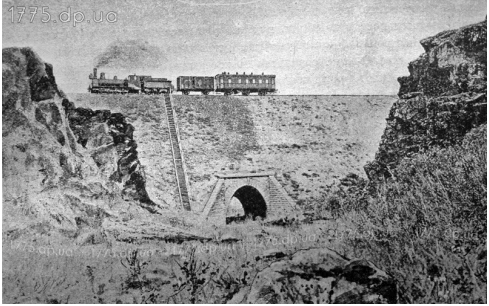TRAINS AS NATION BUILDERS IN UKRAINE

As you know I have always loved trains. Sometimes they say that the genes have memory. Maybe they are as one of my ancestors was involved in engineering of railways when he moved to live to Yekaterinoslav, a city named in honor of Empress Catherine II (ounded in 1776 (now Dnipro city in the Eastern Ukraine). He was a German, Baron Von Beck if my spelling is corrrect.
I was recently asked to write a little history sketch on the so-called the European period in the development of this region so I’ll share some bits of it I found interesting. The Germans, the French, the Belgians, the English and other Europeans cooperated with local authorities of Yekaterinoslav Governorate , by organizing various societies and enterprises, investing and sharing knowledge.
The peculiarity of the industrial development of Yekaterinoslav province was its internationalism. All this led to a boom in the region in the 1880s. This region turned into the most important industrial center in the south of the country. In the 1880s, the ferrous metallurgy of the south was formed, represented by the extraction of iron and manganese ores and the production of pig iron, steel, and rolled metal.
As early as 1869, the territory of the province was crossed by the first railway – the Kursk-Kharkov-Azov. Which, on November 15, 1873, was opened for the passenger and freight traffic section of the Lozovaya-Aleksandrovsk railway, with a branch to Yekaterinoslav stretching for over 208 kilometers/129 miles. This site, which was part of the Lozovaya-Sevastopol line, laid the foundation for the Catherine (now Pridneprovskaya) Railway, the first line of which, with a total length of over 614 kilometers/381 miles, entered service in 1875.
In 1884, with the construction of a two-tiered metal bridge across the Dnieper near Yekaterinoslav, the railway connected the Krivoy Rog Ore and Donetsk Coal Basins. Obviously construction of railways was one of the most important components for the development of the region. The locomotive depot of Yekaterinoslav became the largest in the south of the Empire
The Germans in Yekaterinoslav province were quite a few, 3.83% of the total population. Our region was one of the first places in the country on number of foreigners, with most of the Europeans coming from the German empire. In total, it was more than 10 thousand or 74.92% of Germans in Russian Empire. Therefore it was not surprising to see their names on pages of history, especially related to railways.
Thus, on May 5, 1867, the highest conditions were approved with Baron Ungern-Sternberg for the construction of a section of the line from Elisavetgrad to Kremenchug with a length of about 130 kilometers/81 miles. Also it should be mentioned that Karl von Mekk– was one of creators of railway transportation of the Russian Empire.
How exactly and at whose disposal my ancestor arrived with the family to the Empire I do not know. Perhaps he was associated with these famous personalities. One can only guess what prompted him to tie bind his fate with Yekaterinoslav, but apparently at that time this city was attractive enough for him to do so.
Near the city, there were a German colony known as Fischerdorf (or Rybalsky) – stretched below the railway bridge to the mouth of Samara River. The book “On the Catherine Railroad”, published in 1903, reports the following information:
“The Rybalskoe colony is nothing but the settlement of the colony of Josefstal, founded almost simultaneously with the latter; currently in Rybalsky about 60 yards with a population of up to 800 souls; there is a school, a forging shop, a brick factory, quarries and two forest piers. Josefsta was one of the richest German colonies, founded under the reign of Catherine II, that by 1903 had 1,800 souls.”
Nearby the Becks had a little mention where the Baron enjoyed spending time with his huntsman. Half a century later, after Revolution and Second War World, his house became a music school.
It is interesting to imagine the life of the international society of Yekaterinoslav during its heyday in the 80s of the 19th century. Now they would be called by modern word- “expats, with their balls in the English Club in the center of the city, ladies promenades with obligatory umbrellas along the avenue, or trips on trams, where each passenger was greeted by a conductor. Certainly on Sundays as respectable believers Becks would go to service in the Lutheran Church of St. Catherine. This Gothic building was built in the middle of the 19th Century.
After all, not much time passed, all these historical buildings remained our heritage, and therefore it is quite possible to imagine the life of that period. And apparently my ancestors were quite happy to live that city if they decided to stay and work.
Perhaps this period in the history of the development of our region is not sufficiently researched and remains little known to the public, but from our oral history, we know that the Dnipro (former Yekaterinoslav) has always been a dynamic city attractive for many nationalities, who invested their labor and capital in its formation. And no wonder when people from many countries work together nothing then success could be expected. The end of 19 beginning of 20th century was the blooming time for this part of the world.